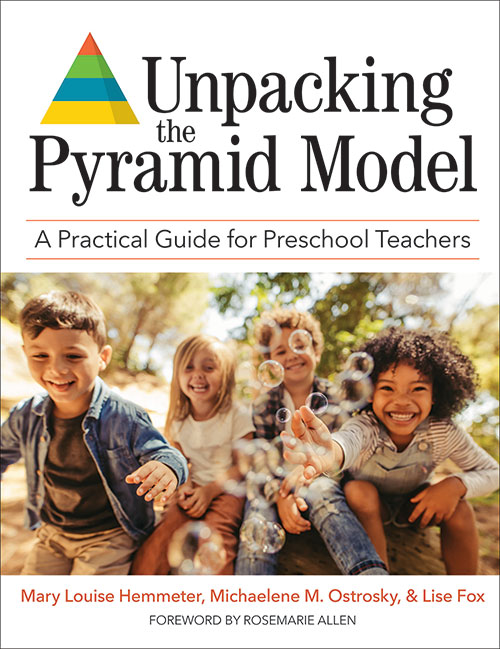 Widely used in early childhood programs, the Pyramid Model for Promoting Social Emotional Competence in Infants and Young Children helps early educators use research-based practices to boost early social-emotional development. If you’re just getting started with the Pyramid Model, or if you’re curious about this approach and have questions, today’s post is for you! Excerpted and adapted from the bestselling guidebook Unpacking the Pyramid Model, edited by Hemmeter, Ostrosky, & Fox, this Q&A addresses some of the most frequently asked questions newcomers have about the Pyramid Model.
Widely used in early childhood programs, the Pyramid Model for Promoting Social Emotional Competence in Infants and Young Children helps early educators use research-based practices to boost early social-emotional development. If you’re just getting started with the Pyramid Model, or if you’re curious about this approach and have questions, today’s post is for you! Excerpted and adapted from the bestselling guidebook Unpacking the Pyramid Model, edited by Hemmeter, Ostrosky, & Fox, this Q&A addresses some of the most frequently asked questions newcomers have about the Pyramid Model.
Is the Pyramid Model a curriculum that I can purchase?
The Pyramid Model is not a curriculum; rather, it is a conceptual framework of evidence-based practices for promoting young children’s social-emotional development. The Pyramid Model organizes evidence-based practices that include universal promotion practices for all children, practices for children who need targeted social-emotional supports, and individualized behavior support practices for children with significant social skill deficits or persistent challenging behavior.
My program has required that we use a particular social-emotional curriculum in our classroom. Can I also use the Pyramid Model with the curriculum?
The Pyramid Model is not intended to replace or supplant a child-level curriculum. To the extent programs use an evidence-based child curriculum, it is likely that the curriculum is consistent with the Pyramid Model framework. The Pyramid Model provides a framework in which teachers can implement a curriculum. Many teachers use a curriculum to structure their social-emotional lessons along with the Pyramid Model, which provides guidance about how to create a social context in which to implement social-emotional teaching practices.
Learn about 6 Essential Pyramid Model Resources!
My school is implementing a Multi-Tiered System of Support (MTSS). Can I still implement Pyramid Model practices?
An MTSS is a framework that is used to ensure successful education outcomes for all students by using a data‐based problem-solving process to provide and evaluate the effectiveness of multiple tiers of integrated academic, behavior, and social-emotional interventions matched to student need. Many programs have successfully implemented, scaled up, and sustained the implementation of the Pyramid Model as an MTSS for promoting young children’s social-emotional competence and addressing challenging behavior.
My school is implementing Positive Behavioral Interventions and Support (PBIS). How does the Pyramid Model work with that school-wide intervention?
The Pyramid Model is a PBIS framework that early educators can use to promote children’s social-emotional development and prevent and address challenging behavior. Many schools that implement PBIS use the Pyramid Model to guide the implementation of practices in early childhood classrooms. (PBIS.org includes information about the use of the Pyramid Model in the implementation of PBIS in early childhood classrooms and programs.) PBIS uses data, systems, and evidence-based practices to improve social competence and academic outcomes for all students in the school. The Pyramid Model offers data decision-making tools and evidence-based practices that are developmentally appropriate for preschool children.
Is there a child assessment component with the Pyramid Model?
The Pyramid Model has no specific child assessment associated with the framework. In recent years, there has been a growing emphasis on the mental health and the social, behavioral, and developmental needs of very young children. In response, state administrators and local providers of infant and preschool programs have worked to strengthen their screening and assessment of children’s social-emotional development.
Can I use the Pyramid Model with children who have special needs?
When the Pyramid Model was developed, it was designed to include practices that promote the social-emotional competence of all children, including children with or at risk for developmental disabilities. Research on the implementation of the Pyramid Model has been conducted in inclusive classrooms and in classrooms that serve children with special needs. Data reveal that implementing the Pyramid Model in these types of classrooms results in teacher-reported growth in social skills and a reduction of challenging behavior.
I am interested in reducing challenging behavior in my classroom. Will the Pyramid Model help with that?
Yes! We have found that implementing the promotion and prevention practices in the Pyramid Model help teachers manage their classrooms and reduce challenging behavior for most children. If children have persistent challenging behavior that is not responsive to the promotion and prevention practices in the Pyramid Model, intensive, individualized interventions are developed to resolve challenging behavior and support the development of new skills. At this tier of the Pyramid Model, program staff and family members collaborate to conduct a functional behavioral assessment and to develop a behavior support plan that is implemented during everyday routines and activities.
Dive deeper into the Pyramid Model with these 4 free, ready-to-watch webinars!
I am interested in something that will help me reach out to families about guiding their children’s social-emotional development. How does the Pyramid Model address family engagement?
The practices that are highlighted in the Pyramid Model are reliant on the participation of families. Teachers who implement the Pyramid Model exchange information with families about how to promote their child’s social-emotional development. (Each chapter in Unpacking the Pyramid Model provides you with ideas and strategies for reaching out to families.)
When children need more instruction or intervention to address social, emotional, or behavioral needs, teachers partner with families to provide increased opportunities for their children to learn and practice new skills in the context of everyday activities and routines in their homes and communities. When children have persistent challenges, families and other persons involved with the child form a collaborative team to develop and implement individualized, comprehensive interventions and supports that are applied in all the child’s routines and activities.
Is the Pyramid Model only for preschool children, or can it be used with infants and toddlers?
The Pyramid Model was designed for use with all children from birth to age 5. Unpacking the Pyramid Model describes practices that are designed to be used in preschool classrooms, but training materials and implementation resources are available for using the Pyramid Model in home-visiting programs and in infant and toddler classrooms.
Have more questions about the Pyramid Model? Find the practical answers you need in the book behind today’s blog post!

Unpacking the Pyramid Model
A Practical Guide for Preschool Teachers
Edited by Mary Louise Hemmeter, Ph.D., Michaelene M. Ostrosky, Ph.D., & Lise Fox, Ph.D.
Created by the Pyramid Model developers and experts with extensive training experience, this is the first book to provide a comprehensive, step-by-step overview of the Pyramid Model. Get a complete overview of the framework, plus in-depth guidance, evidence-based strategies, and helpful checklists for implementing all tiers of the Pyramid Model: universal, targeted, and individualized.
Stay up to date on the latest posts, news, strategies, and more!
Sign up for one of our FREE newslettersMore posts like this

6 Essential Pyramid Model Resources
October 27, 2022
4 Free Webinars that Help You Make the Most of the Pyramid Model
June 16, 2022


Write a Comment
Your email address will not be published. Required fields are marked *
Post a Comment